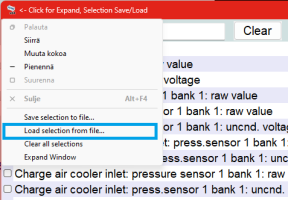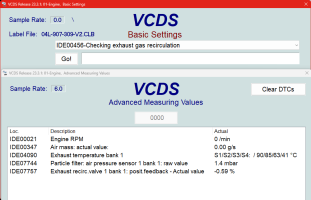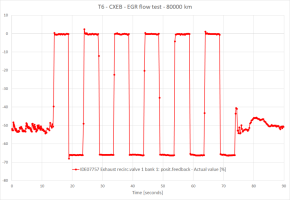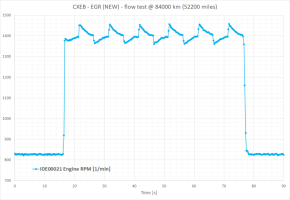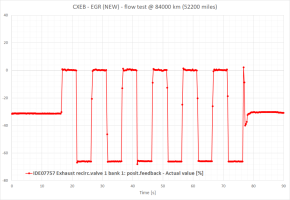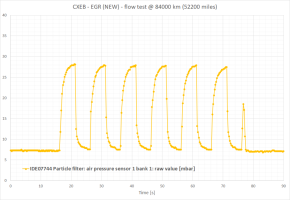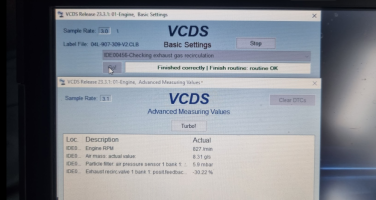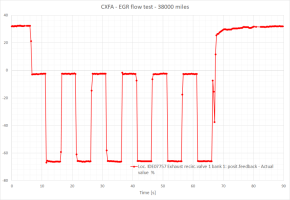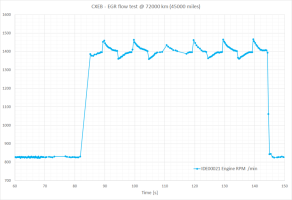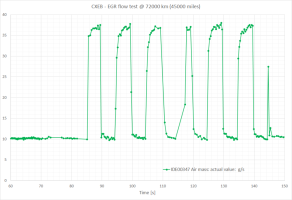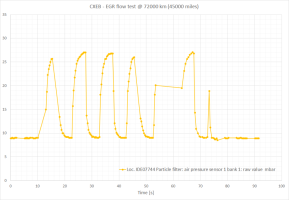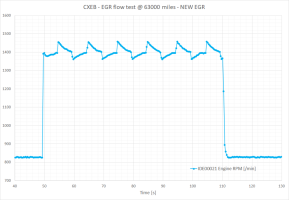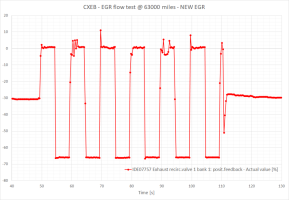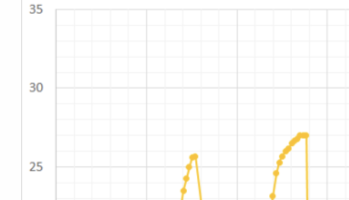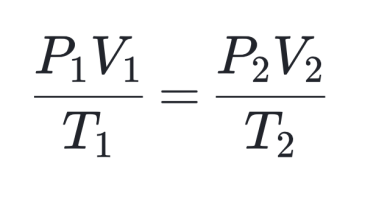So it seems - inevitable P0401.
Well, visited a VW garage to be tested - the van had accumulated 30 events in ECU's memory since July 2021 (since 20 months now). Eventually managed turn on the emission light at event number 31 - thus had a priviledge to have EGR flow tested. The result - pending - the ODIS went to an unending loop without a concluding result.
Meanwhile, I think I have reproduced the EGR flow test using VCDS. However, I don't have any reference value to estimate the degree of EGR cooler blockage. Neither did ODIS tell the reference value (should have told but the computer said no) - thus the final test is still pending.
EDIT (20.9.2024):
The pass/fail threshold value is for air mass flow LOW/HIGH < 0.41. See here Egr fault P0401
The results in this thread were calculated for air mass HIGH/LOW thus pass value would be greater than 1/0.41 = 2.44
Dear Forum members, I would appreciate if members equipped with VCDS could run the T6 engine's built-in test for EGR and post the result files here for future reference. I'm more than happy to provide the graphs in return. The more the merrier!
@Dellmassive - I'm intrigued to see how the new EGR performs!

 www.t6forum.com
www.t6forum.com
Well, visited a VW garage to be tested - the van had accumulated 30 events in ECU's memory since July 2021 (since 20 months now). Eventually managed turn on the emission light at event number 31 - thus had a priviledge to have EGR flow tested. The result - pending - the ODIS went to an unending loop without a concluding result.
Meanwhile, I think I have reproduced the EGR flow test using VCDS. However, I don't have any reference value to estimate the degree of EGR cooler blockage. Neither did ODIS tell the reference value (should have told but the computer said no) - thus the final test is still pending.
EDIT (20.9.2024):
The pass/fail threshold value is for air mass flow LOW/HIGH < 0.41. See here Egr fault P0401
The results in this thread were calculated for air mass HIGH/LOW thus pass value would be greater than 1/0.41 = 2.44
Dear Forum members, I would appreciate if members equipped with VCDS could run the T6 engine's built-in test for EGR and post the result files here for future reference. I'm more than happy to provide the graphs in return. The more the merrier!

@Dellmassive - I'm intrigued to see how the new EGR performs!
How to:
General conditions
- Download the attached measurement setup file TEST_EGR_DPF_FLOW.u01 - remove the .PDF extension so it will become a VCDS compatible .u01 file
- Alternatively can also tick the parameters individually as on screen captures further down
- Proceed as below - preferably immediately after a (minimum of 15 minute) drive so everything is warmed up - for comparable results.
- Before coming to halt switch off Stop/Start and turn off AC .
- Let engine idle
- == Unfortunately can't proceed if DPF regeneration is in progress ==
(1) Create engine blockmap data file
VCDS > Applications > Controller Channel Map >
- Tick the boxes as above and click Go
- VCDS flashes screen for approx. two minutes. When finished click Done, Go Back
(2) Run engine's built-in EGR flow test
- VCDS > Select > Engine > Basic Settings
- Select - Show Measuring Data
- Load measurement setup file TEST_EGR_DPF_FLOW.u01 (Load selection from file)
- Click Log , enter file name
- Click Start (VERY IMPORTANT STEP!!)
- Select IDE00456-Checking exhaust gas recirculation (from pull-down menu if not shown)
- Click Go!
- Proceed as instructed on screen (Hold brake pedal and accelerator pedal) - test runs 60 seconds
- When finished make a note of the message and let logging run for another 15 seconds
- Stop (the data logging)
- Done, close
- Back out from Basic Settings, Close controller, etc. exit VCDS
- Switch off the engine, etc.
(3) Please post the logs (2 files)
- The log files (2 of them) are in folder C:\Ross-Tech\VCDS\Logs\...
- The file Blockmap-01...CSV is a package of approx 1500 engine parameters - for further and possibly future evaluation of the test (e.g blockage vs. mileage vs. DPF ash accumulation)
- Besides the above the collecting the above at (1) lets engine and exhaust temperatures stabilise so can be compared with others recorded similarly
- The actual log file LOG-01-.....CSV (or named by you) contains timestamped measured values.
- The particle filter air pressure sensor here is a kind of extra bit - a try to evaluate DPF condition as it's pressure loss is measured controlled way - though needs to be compared with soot and ash masses at the moment of testing (these are found in blockmap).
Thank you very much in advance!
Other related threads
EDIT 17.3.2024:
EGR valve test procedure - actual vs. requested EGR valve position
Possibly related fault: P046C

EGR Valve Self Test Procedure (IDE00242)- P046C?
So, I've been getting the all too common P046C fault code along with P2457 (Insufficient EGR Cooling Performance). Neither alone will flag a check engine light but combined they sometimes seem to. To try to figure out what is going on, I ran an EGR Flow test on VCDS using instruction from @mmi...
Attachments
Last edited:




